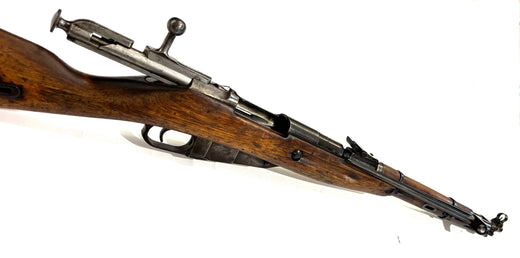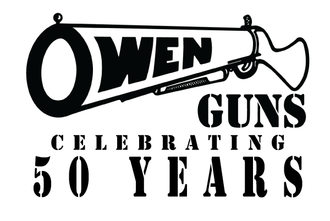
The Russian Mosin Nagant

This week for Firearm Friday we are bringing you the Mosin-Nagant Rifle, specifically a carbine version with a fold out bayonet and we have a few more around the museum just come and have a look.

The Mosin–Nagant is a five-shot, bolt-action, internal magazine–fed military rifle. Known officially as the 3-line rifle M1891, in Russia and the former Soviet Union as Mosin's rifle and informally just mosinka, it is primarily found chambered for its original 7.62×54mmR cartridge.

Developed from 1882 to 1891, it was used by the armed forces of the Russian Empire, the Soviet Union and various other states. It is one of the most mass-produced military bolt-action rifles in history, with over 37 million units produced since 1891. In spite of its age, it has been used in various conflicts around the world up to the present day.

Various weapons were acquired and tested by GAU of the Ministry of War of the Russian Empire, and in 1889 the Lebel Model 1886 rifle was obtained through semi-official channels from France. It was supplied together with a model of the cartridge and bullet but without primer or smokeless powder.

In 1889, three rifles were submitted for evaluation: Captain Sergei Ivanovich Mosin of the imperial army submitted his "3-line" rifle; Belgian designer Léon Nagant submitted a "3.5-line" design; and Captain Zinoviev submitted another "3-line" design.

When trials concluded in 1891, the evaluators were split in their assessment. The main disadvantages of Nagant's rifle were a more complicated mechanism and a long and tiresome procedure of disassembling. Mosin's rifle was mainly criticized for its lower quality of manufacture and materials, due to "artisan pre-production" of his 300 rifles. The commission initially voted 14 to 10 to approve Mosin's rifle. At this point the decision was made to rename the existing commission and call it Commission for creation of the small-bore rifle, and to put on paper the final requirements for such a rifle. The inventors obliged by delivering their final designs. Head of the commission, General Chagin, ordered subsequent tests held under the commission's supervision, after which the bolt-action of Mosin's design was ordered into production under the name of 3-line rifle M1891.

The colloquial name "Mosin-Nagant" used in the West is persistent but erroneous. Like the Gewehr 98, the 1891 Mosin uses two front-locking lugs to lock up the action. However, the Mosin's lugs lock in the horizontal position, whereas the Mauser locks vertically. The Mosin bolt body is multi-piece whereas the Mauser is one piece. The Mosin uses interchangeable bolt heads like the Lee–Enfield. Unlike the Mauser, which uses a controlled feed bolt head in which the cartridge base snaps up under the fixed extractor as the cartridge is fed from the magazine, the Mosin has a push feed recessed bolt head in which the spring-loaded extractor snaps over the cartridge base as the bolt is finally closed, the Mosin uses a blade ejector mounted in the receiver. The Mosin bolt is removed by simply pulling it fully to the rear of the receiver and squeezing the trigger, while the Mauser has a bolt stop lever separate from the trigger.

The bolt lift arc on the Mosin–Nagant is 90 degrees. The Mauser bolt handle is at the rear of the bolt body and locks behind the solid rear receiver ring. it is attached to a protrusion on the middle of the bolt body, which serves as a bolt guide, and it locks protruding out of the ejection/loading port in front of a split rear receiver ring. The rifling of the Mosin barrel is right turning (clockwise looking down the rifle) 4-groove with a twist of 1:9.5" or 1:10". The 5-round fixed metallic magazine can either be loaded by inserting the cartridges individually, or more often in military service, by the use of 5-round stripper clips.

With the start of World War I, production was restricted to the M1891 dragoon and infantry models for the sake of simplicity. Due to the desperate shortage of arms and the shortcomings of a still-developing domestic industry, the Russian government ordered 1.5 million M1891 infantry rifles from Remington Arms and another 1.8 million from New England Westinghouse Company in the United States in 1915. (Russia had not paid for the order at any time throughout the Great War).
Many of the New England Westinghouse and Remington Mosin–Nagants were sold to private citizens in the United States before World War II through the office of the Director of Civilian Marksmanship, the predecessor to the federal government's current Civilian Marksmanship Program.
Large numbers of Mosin–Nagants were captured by German and Austro-Hungarian forces and saw service with the rear-echelon forces of both armies, and also with the Imperial German Navy. Many of these weapons were sold to Finland in the 1920s. At the beginning of World War II, the Mosin–Nagant 91/30 was the standard-issue weapon of Soviet troops. Millions were produced in World War II for use by the largest mobilized army in history.
A book published by the Japanese Army Magazine in 1938, quoted a Soviet Red Army military adviser's conversation, talking about the Mosin-Nagant sniper rifles (with a PE or PEM scope), which were used by the Chinese military in the Battle of Shanghai (1937), caused great losses to the Japanese army. The Mosin–Nagant Model 1891/30 was modified and adapted as a sniper rifle from 1932 onwards, first with mounts and scopes from Germany then with domestic designs (PE, PEM) from 1931; from 1942 it was issued with 3.5-power PU fixed focus scopes. It served quite prominently in the brutal urban battles on the Eastern Front, such as the Battle of Stalingrad, which made heroes of such snipers as Vasily Zaitsev, Lyudmila Pavlichenko, Ivan Sidorenko, and Roza Shanina. Finland also employed the Mosin–Nagant as a sniper rifle, with similar success with their own designs and captured Soviet rifles.
In 1935–1936, the 91/30 was again modified, this time to lower production time. The "hex" receiver was changed to a round receiver. When war with Germany broke out, the need to produce Mosin–Nagants in vast quantities led to a further simplification of machining and a falling-off in finish of the rifles. The wartime Mosins are easily identified by the presence of tool marks and rough finishing that never would have passed the inspectors in peacetime. However, despite a lack of both aesthetic focus and uniformity, the basic functionality of the Mosins was unimpaired.
In addition, in 1938 a carbine version of the Mosin–Nagant, the M38, was issued. It used the same cartridge and action as other Mosins, but the barrel was shortened by 21.6 cm to bring the weapon down to an overall length of 101.6 cm, with the forearm shortened in proportion. The idea was to issue the M38 to troops such as combat engineers, signal corps, and artillerymen, who could conceivably need to defend themselves from sudden enemy advances, but whose primary duties lay behind the front lines. Significantly, the front sight of the M38 was positioned in such a way that the Model 91/30's cruciform bayonet could not be mounted to the muzzle even if a soldier obtained one.
An increase in urban combat led directly to the development of the Model M44 Mosin. In essence, the M44 is an M38 with a slightly modified forearm and with a permanently mounted cruciform bayonet that folds to the right when it is not needed. It was an improvement on the Model 91/30, particularly for urban warfare; but few M44s saw combat on the Eastern Front.
By the end of the war, approximately 19.8 million Mosin–Nagant rifles had been produced.













